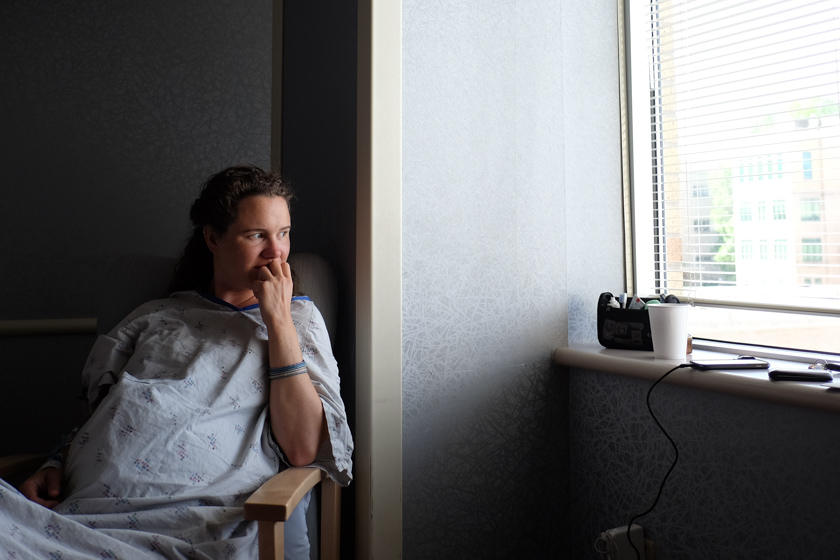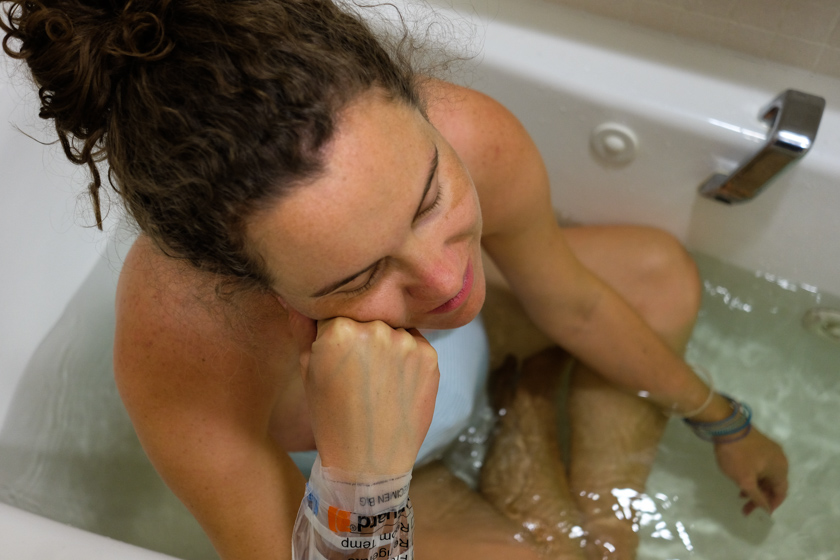This is the third post in a five part series about how and why Rachael and I ended up delaying our return to Qatar. Click here for the next post, or click here to go back to the first post.
At 4 a.m. on Friday Rachael got out of bed and found some blood on the sheets, so we called Labor and Delivery at OHSU and asked if they wanted us to come in.
The first person we talked to said to keep an eye on it and call if anything changes, but as soon as we hung up the phone it rang back at us, this time with a doctor on the other end. She wanted us to come in, so we grabbed the hospital bag we’d packed a few days before and drove up to OHSU.
A nurse named Lisa in Labor and Delivery showed us into Room 7 and gave Rachael a hospital gown to change into. Then Lisa placed two monitors on her belly, one for measuring contractions and the other for measuring the baby’s heart rate. As soon as she had it in the right place we could hear the heartbeat playing out quickly over the speakers. Bump, bump, bump, bump. The nurse said it sounded perfect, and Rachael and I breathed a sigh of relief.
 Rachael outside Labor and Delivery early on in our stay at the hospital. This was when the doctors were still letting Rachael leave the unit.
Rachael outside Labor and Delivery early on in our stay at the hospital. This was when the doctors were still letting Rachael leave the unit.
An hour or so later several doctors came through to check in on Rachael and do a cervical exam. Rather than just having one doctor, we actually had three residents, plus an attending physician. An extra nurse was in the room during this first consult, too, which brought the count to four doctors, two nurses, and the two of us. Needless to say, we felt very popular.
Dr. Mase conducted the cervical exam and found that Rachael was indeed beginning to dilate. She also found more blood: four or five tablespoons. This seemed like a lot, but no one appeared very concerned about it, so I tried not to worry about it either. Dr. Manriquez predicted a delivery before the end of the day or perhaps early tomorrow morning and told us that they’d conduct an ultrasound before long to make sure things were okay inside the womb.
Just as we’d had to do a week earlier when we visited Dr. Hayes, Rachael and I continued to process the prospect of delivering a premature baby. The gestational age was 35 weeks plus four days — about a month shy of 40 weeks. Our hopes were buoyed by the doctors’ assertion that the vast majority of babies born at this stage do just fine. Still, there was plenty to be anxious about. In order to minimize my worries, I told myself that I wouldn’t look anything up on Google while we were in the hospital. If I had a question, I’d ask one of the doctors who would be aware of our particular situation and who would know better than to scare the bejesus out of us by running through everything that could possibly go wrong. Or so I thought — more on that in a bit.
 We had a lot of time with nothing to do but think.
We had a lot of time with nothing to do but think.
After several hours of strong contractions that had Rachael holding her breath and pausing in the middle of sentences things just…stopped. Her contractions became weaker and further apart. She stopped dilating. This was bad news in the sense that we were excited and getting ourselves ready to have a baby, but it was great news in the sense that the longer the baby stayed in the womb, the healthier it was likely to turn out. No one else was in any rush to deliver the baby, so all that was left to do was wait and figure out what had caused the bleeding and early labor.
Toward the end of the day the team of doctors returned to discuss the ultrasound. They said there were some encouraging things, like that the baby appeared to be around seven pounds three ounces (the average full-term baby is about seven and a half pounds, so ours appeared big for its gestational age), that Rachael’s amniotic sac still contained plenty of fluid (indicating that it was still intact, reducing the risk of infection), and that if the initial bleeding had been caused by a placental abruption (where some or all of the placenta separates from the uterine wall), it was minor and not progressing. Not encouraging but not necessarily concerning was that they had seen what appeared to be a small calcification in the baby’s stomach. They’d also noticed some calcification on Rachael’s placenta which was either a sign that something was wrong, or simply that her placenta was “getting old.” On a positive note, the baby had so much hair that it showed up on the ultrasound. It even looked curly, just like Rachael’s.
 The birthing suites have bathtubs in them to help ease the pains of labor. Rachael took full advantage.
The birthing suites have bathtubs in them to help ease the pains of labor. Rachael took full advantage.
The contractions came and went through the night, and before we knew it the sun was rising again. The doctors came by our room right after we ate breakfast to discuss next steps. They didn’t know what the calcifications meant, so they called in a high-risk pregnancy specialist to have a look. Dr. Wyatt had barely introduced herself before she launched into all of the things that could be wrong with Rachael’s pregnancy: cystic fibrosis, toxoplasmosis, cytomegalovirus, cerebellar hypoplasia, and so on. I had only the faintest idea what most of these things were, except that they were obviously bad things that you did not want. They’d run tests for them, she said, and try to rule them out. And I would try not to cry.
Rachael was tearing up as Dr. Wyatt ran through the list, and so I tried to hold it together so that I could support her. At just that moment, when it seemed like everything was going wrong, or at least about to, our family doctor walked into the delivery room. I honestly don’t know Dr. Hayes that well, but seeing her in that moment brought a tremendous amount of comfort, as if she alone could guarantee that our fears would not be realized. Tears welled in my eyes and I bit my lip to contain them. She sat down next to Rachael and I and explained that these were all precautionary tests with a low likelihood of coming back positive. “Dr. Wyatt just wants to be sure.”
At the end of our second day in the Labor and Delivery Unit we got the word that Rachael would be moved upstairs to the Mother Baby Unit to wait out the rest of her pregnancy. The plan was to wait until labor spontaneously restarted. If it didn’t, they’d induce her in a week when the baby would be 37 weeks old and no longer considered a preemie.
Rachael’s parents happened to be visiting so they helped us pack up our stuff and take it upstairs. The new room was smaller than the first, but the view was better, Rachael’s bed was more comfortable, and I had my own place to sleep.
 The room they moved us to upstairs was smaller but with nicer beds and a beautiful view.
The room they moved us to upstairs was smaller but with nicer beds and a beautiful view.
I stayed up late during our first night in the new room. Rachael was sleeping more soundly on her new bed and I was much more relaxed thanks to not having to listen to the beep beep beep of the fetal heart rate monitor. I put on my headphones and contemplated everything that had transpired over the past few days. All I could think about was how thankful I was to the nurses, for being emotionally and physically available whenever we’d needed them, and to the doctors, for being attentive to our concerns and diligent in their pursuit of answers (even if the questions were scary). Even the cafeteria staff smiled and joked with me when I went downstairs to pick up our meals.
There’s a scene in the movie Shrek where he’s trying to explain to Donkey what it’s like to be an ogre. We’re like onions, he says, with layers. Of course Donkey doesn’t get the point, but I kept thinking about that scene as the events I’m now writing about transpired. Forgive the deep emotional dive, but I feel like I live my life surrounded by lots of layers. When scary things happen, off comes a layer. When bad things happen, off comes a layer. When we first learned that our baby would likely be coming earlier than we’d planned, I lost a layer. When we saw blood another layer came off, and then several more when they checked Rachael into the hospital. When Dr. Wyatt told us everything that could be wrong with Rachael and the baby, I lost the rest of them.
The bad thing about losing those layers of personal protection is that I felt like it wouldn’t take much else to break me. How could I possibly handle a positive diagnosis of cystic fibrosis? Or of a problem with the baby’s brain? But the good thing about losing them is that it took away the guard I keep up around myself that I know prevents me from really connecting with other people. It was so nonexistent that even the simplest, most ordinary gestures of kindness would make me tear up. If I was walking in the hallway and someone smiled as they passed me, I’d start to tear up. I kept thinking over and over how important it is to not just respect other people, or accept them, or celebrate them, but to really love them. To share your love with every person you meet, every day, in every moment.
The next three days passed slowly and uneventfully. We met several shifts worth of nurses and a few more doctors. Dr. Manriquez transferred to another shift and was replaced by Dr. Alawi. Dr. Goss, who’d been there since the beginning, kept us laughing with her contagious smile. She was so warm and positive that I feel like she could tell you that you had an inoperable brain tumor and have you laughing by the end of the conversation.
The toxoplasmosis test came back negative, as did the cytomegalovirus test. We’d have to wait another week for the cystic fibrosis test, and checking the baby’s cerebellum would happen after delivery. Besides that, it was just waiting. And waiting. And waiting.
Click here for the next post in the series.